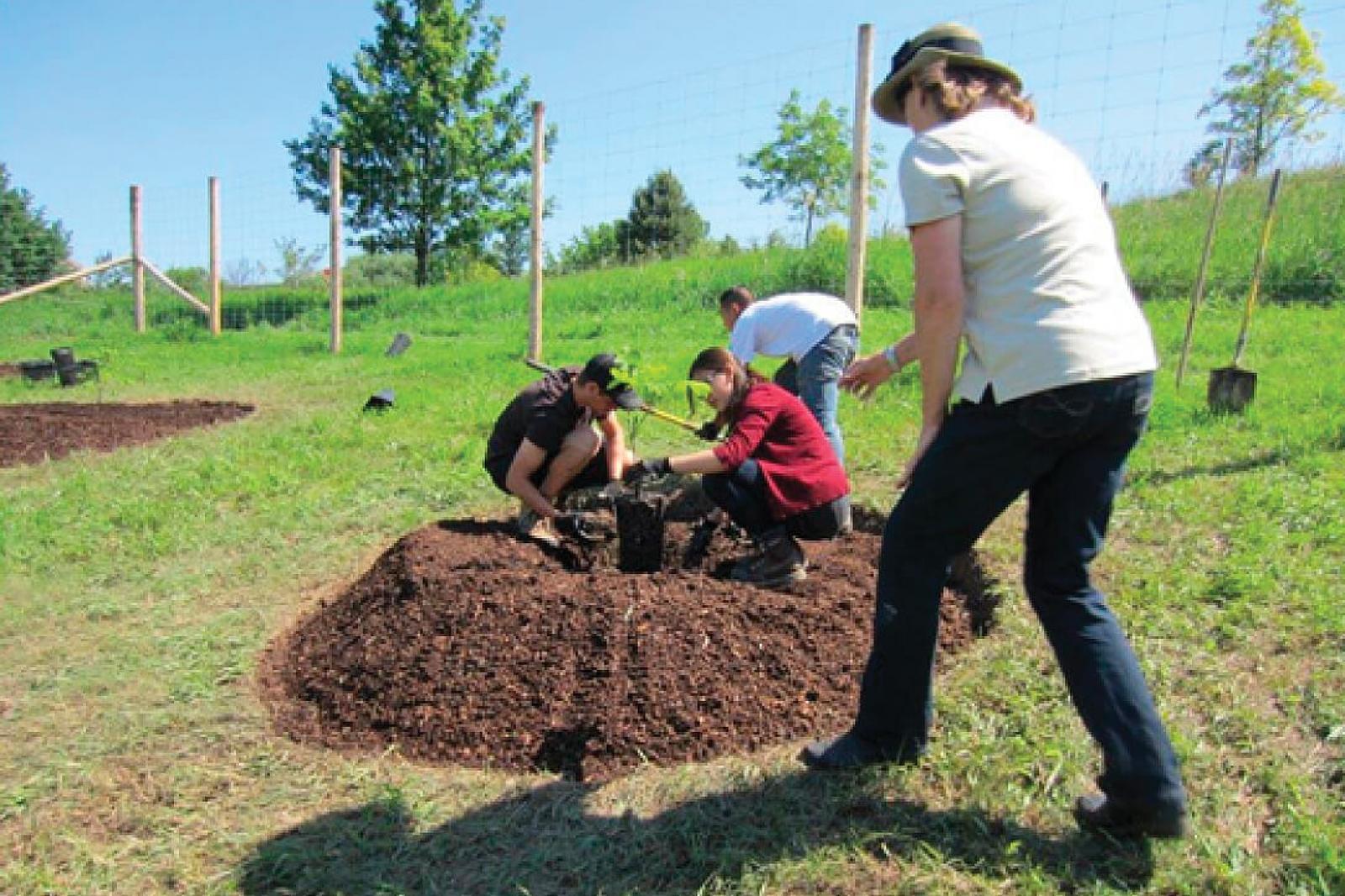October 15, 2013

Students planting a four-year grafted butternut at Humber Arboretum
Humber launches project to conserve endangered trees
If a tree falls in the forest, does anyone hear?
Humber staff and students working to save the endangered butternut tree hear the crashes loud and clear.
The tree is a native of the deciduous Carolinian forests of southern Ontario, Quebec and New Brunswick, and it’s facing extinction because of a widespread fungal canker that extends throughout the tree’s range.
To help save the species, Humber has teamed up with Ontario’s Ministry of Natural Resources to grow new trees, planting five saplings in an enclosure in the Arboretum, with plans to plant up to 20 more.
As well, professors and students will investigate alternatives to current propagation techniques.
“Right now, the only way to create canker-resistant trees is to graft a part of a healthy butternut onto another tree’s root stock,” explains Gino Teolis, a professor in Humber’s Landscape Technician program. “This is time-consuming, difficult and the success can be variable. We’re investigating ways of propagating healthy trees through cuttings. For example, we will try to determine the best medium for them to grow in, and whether rooting hormones will help.”
Growing trees from cuttings would reduce the time required to plant new trees. Currently, a grafted sapling isn’t ready to plant for four years, while trees grown from cuttings would be ready to plant in one year.
As well, the process of propagating from cuttings is a far less finicky task than grafting, which Humber greenhouse technician Valeria Wuschnakovski likens to “doing surgery, only harder.”
Why worry about saving the butternut in the first place?
“Biodiversity is crucial for all life on earth, and the survival or extinction of a single species affects the entire ecosystem,” explains Alix Link, the director of the Humber Centre for Urban Ecology and the Humber Arboretum. “As an Arboretum, we exist for the purpose of conservation and education – we have more than 1,700 species of plants and animals across 240 acres of Carolinian forest, which is some of the most biodiverse in Canada.”
The project has also created collaborative partnerships between Humber, the Ministry of Natural Resources, and the Guelph University arboretum, and created research opportunities for Humber staff and students alike.
Landscape technician student Kelly Park is working with Teolis as a research assistant, and says she appreciates the chance to apply her classroom knowledge to a real-world research setting.
“We learn about grafting in class, and here I got to apply my knowledge by actually doing the work,” she says. “I’m looking forward to seeing the results of our work with the cuttings. We’ve done a lot of research and I’m curious to see how it will turn out.”
Humber staff and students working to save the endangered butternut tree hear the crashes loud and clear.
The tree is a native of the deciduous Carolinian forests of southern Ontario, Quebec and New Brunswick, and it’s facing extinction because of a widespread fungal canker that extends throughout the tree’s range.
To help save the species, Humber has teamed up with Ontario’s Ministry of Natural Resources to grow new trees, planting five saplings in an enclosure in the Arboretum, with plans to plant up to 20 more.
As well, professors and students will investigate alternatives to current propagation techniques.
“Right now, the only way to create canker-resistant trees is to graft a part of a healthy butternut onto another tree’s root stock,” explains Gino Teolis, a professor in Humber’s Landscape Technician program. “This is time-consuming, difficult and the success can be variable. We’re investigating ways of propagating healthy trees through cuttings. For example, we will try to determine the best medium for them to grow in, and whether rooting hormones will help.”
Growing trees from cuttings would reduce the time required to plant new trees. Currently, a grafted sapling isn’t ready to plant for four years, while trees grown from cuttings would be ready to plant in one year.
As well, the process of propagating from cuttings is a far less finicky task than grafting, which Humber greenhouse technician Valeria Wuschnakovski likens to “doing surgery, only harder.”
Why worry about saving the butternut in the first place?
“Biodiversity is crucial for all life on earth, and the survival or extinction of a single species affects the entire ecosystem,” explains Alix Link, the director of the Humber Centre for Urban Ecology and the Humber Arboretum. “As an Arboretum, we exist for the purpose of conservation and education – we have more than 1,700 species of plants and animals across 240 acres of Carolinian forest, which is some of the most biodiverse in Canada.”
The project has also created collaborative partnerships between Humber, the Ministry of Natural Resources, and the Guelph University arboretum, and created research opportunities for Humber staff and students alike.
Landscape technician student Kelly Park is working with Teolis as a research assistant, and says she appreciates the chance to apply her classroom knowledge to a real-world research setting.
“We learn about grafting in class, and here I got to apply my knowledge by actually doing the work,” she says. “I’m looking forward to seeing the results of our work with the cuttings. We’ve done a lot of research and I’m curious to see how it will turn out.”